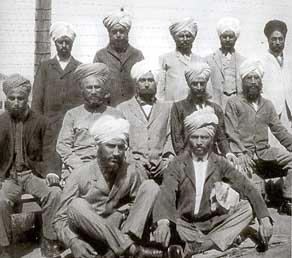By SONIA PAUL
ANGEL ISLAND, Calif.
Despite inclement weather conditions, members of the Angel Island Immigration Station Foundation, state park officials, former island detainees, volunteers and supporters gathered Feb. 15 on the San Francisco Bay’s largest island to mark the official re-opening of the Angel Island Immigration Station.

"Poem 69," carved into a wall at the Angel Island
Immigration Station in San Francisco Bay,
Nearly 40 years ago, park ranger Alexander Weiss first rediscovered Chinese poetry on the deteriorating walls of the island detention barracks in 1970. Other languages discovered on the walls included Japanese, Korean, Russian and Punjabi.
Thousands of immigrants passed through Angel Island between 1910 and 1940, earning it the title of the “Ellis Island of the West.” Due to the downward spiral of the U.S. economy and subsequent anti-immigration regulations, particularly the Chinese Exclusion Act of 1882, Angel Island was known for detaining immigrants anywhere from days to years.

Sikhs Allowed to land - San-Francisco-Chronicle
6-April-1899.
Detainees found ways to pass the time, attempting to lead as normal a life as possible. Many coped with their stay by writing poetry on the walls of the detention center. These now-famous poems serve as beautiful testaments to many facets of the immigrants’ experiences, such as the reasons they came and how they felt once they arrived. Their stories are vivid, emotional reminders of disappointment and struggle in a search for a new life in a new land. These poems covered the walls of the barracks, no doubt providing inspiration and comfort to the detainees that followed.
Punjabi Sikhs were among the first Indians to immigrate to California in the early 1900s and more than 7,000 of them passed through Angel Island. The Punjabi writing carved onto a wall and pole on the second floor of the main barrack is particularly revealing of Indian immigration history.
The station re-opened to the public to reveal a living museum within the main barracks building. Rooms were stationed with crowded bunk beds, clothes, games, photos and other period items immigrants might have had with them upon arrival to Angel Island. Soundscapes in certain rooms, featuring a number of different Asian languages, including Punjabi, were also on hand to help recreate the immigrant experience for visitors.
“It’s a nice physical experience to actually see where these immigrants were staying and how they were treated and how they were living,” a young Indian student remarked as she took note of the Punjabi writing on the pole. She and her two friends were one of the numerous people who braved the rainy weather conditions to come out for the event.

Figures from United States Bureau of Naturalization

Group of sikh immigrants, Angel Island, 1910
courtesy of California State Parks
Speaking at the dedication ceremony, Kathy Lim Ko, president of the Angel Island Immigration Station Foundation, remarked on the significance of the re-opened station.
“The immigration station is a site of conscience, about immigration past, present, and future. It is a place for reflection on the very personal immigration experience, but also on international relations and social justice,” she said.
For the first time ever, all areas within the historically significant barracks (where the priceless poems etched into the walls are located) will be open to the public.
Article courtesy: www.indiawest.com
For information on visiting Angel Island, please visit http://www.parks.ca.gov/?page_id=468

